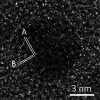Formation of Nanodiamonds during Pyrolysis of Butanosolv Lignin
- PMID: 39177501
- PMCID: PMC11394345
- DOI: 10.1021/acsnano.4c02950
Formation of Nanodiamonds during Pyrolysis of Butanosolv Lignin
Abstract
The preparation of artificial diamonds has a long history driven by decreased costs compared to naturally occurring diamonds and ethical issues. However, fabrication of diamonds in the laboratory from readily available biomass has not been extensively investigated. This work demonstrates a convenient method for producing nanodiamonds from biopolymer lignin at ambient pressure. Lignin was extracted from Douglas Fir sawdust using a butanosolv pretreatment and was pyrolyzed in N2 at 1000 °C, followed by a second thermal treatment in 5% H2/Ar at 1050 °C, both at ambient pressure. This led to the formation of nanodiamonds embedded in an amorphous carbon substrate. The changes occurring at various stages of the pyrolysis process were monitored by scanning electron microscopy, Fourier transform infrared spectroscopy, and nuclear magnetic resonance spectroscopy. High resolution transmission electron microscopy revealed that nanodiamond crystallites, 4 nm in diameter on average, formed via multiple nucleation events in some carbon-containing high density spheres. It is proposed that highly defected graphene-like flakes form during the pyrolysis of lignin as an intermediate phase. These flakes are more deformable with more localized π electrons in comparison with graphene and join together face-to-face in different manners to form cubic or hexagonal nanodiamonds. This proposed mechanism for the formation of nanodiamonds is relevant to the future fabrication of diamonds from biomass under relatively mild conditions.
Keywords: electron microscopy; lignin; multiple nucleation; nanodiamond; pyrolysis.
Conflict of interest statement
The authors declare no competing financial interest.
Figures






Similar articles
-
Mechanistic features of nanodiamonds in the lapping of magnetic heads.ScientificWorldJournal. 2014;2014:326427. doi: 10.1155/2014/326427. Epub 2014 Jun 22. ScientificWorldJournal. 2014. PMID: 25045730 Free PMC article.
-
Fabricating Graphene and Nanodiamonds from Lignin by Femtosecond Laser Irradiation.ACS Omega. 2021 Dec 6;6(49):33995-34002. doi: 10.1021/acsomega.1c05328. eCollection 2021 Dec 14. ACS Omega. 2021. PMID: 34926947 Free PMC article.
-
Preparation of fluorescent magnetic nanodiamonds and cellular imaging.J Am Chem Soc. 2008 Nov 19;130(46):15476-81. doi: 10.1021/ja804253y. Epub 2008 Oct 22. J Am Chem Soc. 2008. PMID: 18939829
-
Formation of nanodiamonds at near-ambient conditions via microplasma dissociation of ethanol vapour.Nat Commun. 2013;4:2618. doi: 10.1038/ncomms3618. Nat Commun. 2013. PMID: 24141249
-
Production of monomeric phenols by thermochemical conversion of biomass: a review.Bioresour Technol. 2001 Sep;79(3):277-99. doi: 10.1016/s0960-8524(00)00180-2. Bioresour Technol. 2001. PMID: 11499582 Review.
Cited by
-
Unveiling the microscopic origin of anomalous thermal conductivity in amorphous carbon.Sci Adv. 2025 Jun 6;11(23):eadx5007. doi: 10.1126/sciadv.adx5007. Epub 2025 Jun 6. Sci Adv. 2025. PMID: 40479064 Free PMC article.
References
-
- Liu W.-J.; Jiang H.; Yu H.-Q. Thermochemical Conversion of Lignin to Functional Materials: a Review and Future Directions. Green Chem. 2015, 17, 4888–4907. 10.1039/C5GC01054C. - DOI
-
- Abbaschian R.; Zhu H.; Clarke C. High Pressure-High Temperature Growth of Diamond Crystals Using Split Sphere Apparatus. Diamond Relat. Mater. 2005, 14, 1916–1919. 10.1016/j.diamond.2005.09.007. - DOI
-
- Iijima S.; Ichihashi T. Single-Shell Carbon Nanotubes of 1-nm Diameter. Nature 1993, 363, 603–605. 10.1038/363603a0. - DOI
LinkOut - more resources
Full Text Sources
Research Materials
Miscellaneous

